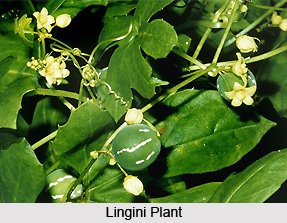 The plant named Lingini is a popular Indian medicinal plant that has the botanical name of Diplocyclos palmatus (L.) C. Jeffrey. The plant is called in several names in different native Indian languages. It is called as Mala or Shivalingani in Bengali and in Gujarati; it is named as Chivalingi, Shivalingi and Shivlingi. Lingini is actually the Sanskrit name of the plant, while Shivalingi is the Hindi name. Its other names in Hindi include Gar-Gumaru and Ishwaralingi. The Marathi speaking people call the plant as Kavadori, Kavalechedole and Vaduballi; and in Telugu, it is called as Lingadonda.
The plant named Lingini is a popular Indian medicinal plant that has the botanical name of Diplocyclos palmatus (L.) C. Jeffrey. The plant is called in several names in different native Indian languages. It is called as Mala or Shivalingani in Bengali and in Gujarati; it is named as Chivalingi, Shivalingi and Shivlingi. Lingini is actually the Sanskrit name of the plant, while Shivalingi is the Hindi name. Its other names in Hindi include Gar-Gumaru and Ishwaralingi. The Marathi speaking people call the plant as Kavadori, Kavalechedole and Vaduballi; and in Telugu, it is called as Lingadonda.
Lingini is a tuberous, slender annual vascular plant that has hairless stems and forked tendrils. The leaves of the plant are ovate-sub-orbicular in outline and they have a length of 7.5-15 cm and width of up to 12 cm. The base of the deeply 3-5-lobed leaves is cordate, the blade membranous and scabrid above with minute red scales. The leaves are smooth or slightly scabrid beneath, while the lobes are lanceolate, acute to acuminate, with margins coarsely. The lobes are also irregularly serrate or sinuate and distantly denticulate. The petioles have a length of 2-5 cm.
The small flowers of Lingini or Shivalingi are of greenish-yellow in colour. The female flowers of the plant are borne in fascicles and the male ones are solitary. The plant`s corolla is about 3-4 mm, with ovate-oblong, acute, pubescent lobes. The fruit or berry of the plant is rounded, with a diameter of 2-3 cm and the bluish-green coloured fruit has eight vertical white streaks. They ripe red and bear a few brown, obovate seeds. The compressed seeds have a length of 4 mm and width of 3 mm and they are usually encircled by a prominent raised band. The plant generally flowers between the months of August and September and fruits in September and October in central India. Lingini or Shivalingi is commonly found throughout India and it is most common and typically found in village hedges.
Lingini or Shivalingi has a number of useful medicinal properties and usages. It is considered bitter, aperient and tonic and it is commonly used for relieving bilious attack. The leaves of the plant are applied topically for getting relief from inflammations. The Indian women sometimes take the seeds in combination with other plant drugs for helping conception and prevent miscarriage. The practitioners of Ayurvedic medicine use the plant`s fruit as an aphrodisiac and tonic, while in Siddha; the entire plant is used for getting relief from constipation.



















